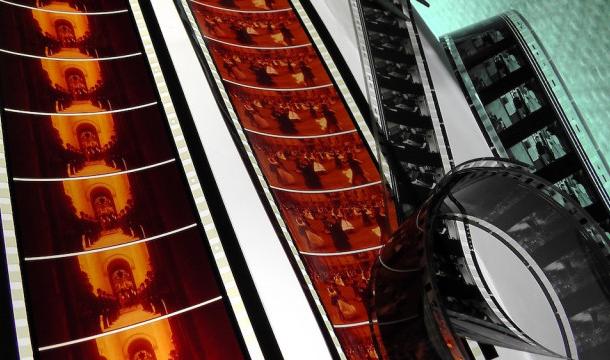North by Northwest and the Birth of Bond

A lot has changed since the fall of the Berlin Wall. With the end of the Cold War, we lost a very fun genre: The spy flick. Oh, sure, it can struggle and gasp along on terrorist plots for awhile, but it just isn't the same thing without that CIA vs. KGB framework.
So, while we resign ourselves to a world where The Hunt for Red October is no longer relevant, we can consider that the spy thriller genre was already long thriving before James Bond hit the big screen. And it got a significant kick from the Master himself, Alfred Hitchcock.
You see, North by Northwest was released in 1959, three years before the first Bond film, Dr. No, in 1962. Now, Bond had already been given his due in TV and radio; starting in 1954 with a TV adaptation of Casino Royalle for a CBS series, an adaptation of Moonraker for radio broadcast in 1956. Which is to say nothing of the James Bond comic books. But Dr. No was the big screen debut of Mr. Bond, and by then the genre was already well-treaded territory.
But when you think of those crazy vehicular stunt battles that Bond films became famous for, you really can't make a case for any of them not being inspired by this famous sequence from North by Northwest (spoiler warning):
Pause and consider that this sequence is taught in film school even today as the best example to show how to set up a dramatic thriller scene. Roger O. Thornhill, an unassuming Madison Avenue marketing drone, has been pried out of his comfy little nest and sent on the proverbial wild goose chase, all over being mistaken for a spy. Once he's out of his element, he's as helpless as an ant on a picnic table in this cornfield arena. Never mind that these guys (who previously tried to off him by trying to stage a drunk driving incident) came from the Batman-villain school of wacky ways to kill someone. Hitchcock openly admitted that by the time we get to Prairie Stop, the story has kissed common sense goodbye. He was counting on the audience being too caught up in the scene to think it over at the time.
When you do think it over (in a moment which is now known by the trope "Fridge Logic," i.e. when you go to the fridge for a snack and away from the movie for a moment), it falls apart. The only reason the bad guys are doing this is because they think Thornhill is rival spy George Kaplan; yet they lured him to the cornfield with the promise of meeting George Kaplan himself, who would supposedly explain what was going on. Quite a bit of this identity shuffling would continue well through the spy genre in the coming decades.
Surrealism has always had a place in spy thrillers. Just ask The Prisoner, a late-60s British TV series with a cult following that grows with each generation. It started each show with this sequence:
From this, you can glean that Patrick McGoohan worked for some sort of agency, angrily resigned, and was kidnapped and taken prisoner to "the Village," where he would be picked apart for "information" and subject to manipulative cat and mouse games at the hands of various sadistic Number Twos. Beyond that, any more detail is anyone's guess.
The James Bond franchise had its share of surreal moments too. Need we point out the various bombs and guns disguised as household items by Q, the ridiculous slide-whistle car-jump, or the deadly hat whirled by Oddjob:
Surrealism was a very real public response to the Cold War situation: the world had simply lost its mind, it seemed. Constantly fighting for no reason other than to come out on top of the Superpower race, hatching bizarre schemes and undercover double-agents to thwart each other's bizarre schemes. The CIA's plans against Fidel Castro alone ran to exploding cigars and hypodermic needles disguised as pens; so now cameras that shoot bullets and not pictures don't seem so silly anymore.
Surrealism in spy drama wasn't just parody; it was art trying to keep up with reality. Small wonder that the last word in parody of the genre was the origins of Mel Brooks' TV career:
And as we mentioned last time, Brooks would go on to parody all of Hitchcock's canon in High Anxiety. UPDATE: Rockstar WFMU blogger Kliph Nesteroff just posted an article discussing more about the show Get Smart, read more there for some fascinating insights.
Hey, hold onto your shoephone, we've come full circle! Because Edward Platt, who played the Chief on Get Smart, is the same actor who played Cary Grant's lawyer in North by Northwest:
Yeah, and how surreal is this whole idea? We're going to pick the home of a U.N. diplomat, pose as him, and not only kidnap our target for interrogation, but entertain guests. And if our subject survives the attempt at intoxicated vehicular manslaughter, we'll just clean the couch cushions, replace the bottles with books, and hey presto, our assassin is now a gardener!
In North by Northwest, one of the first lines of dialogue is a note Cary Grant wants his secretary to leave him: "Think thin!" The last two lines of dialogue we hear are "This is silly," and "I know, but I'm sentimental." Yes, think thin, because if you think too thickly, our silly, sentimental spy thriller will fall apart like Watergate testimony. You might wonder why van Damme ever expected a real, trained spy to answer to a telegram page at a hotel bar in the first place. Their whole set-up wouldn't have nabbed a real spy; but it was perfect for embroiling the first hapless businessman to bumble along.
Hitchcock did not do this first; but he was what we call the trope codifier for spy shenanigans in film ever since. Bold, brassy stunts, impossible plots to take over the world, larger-than-life villains with a mouthful of metal teeth, and a story that spends more time rushing from place to place than asking where it's going and why.

 A new era for Millennial favorite, Linkin Park
A new era for Millennial favorite, Linkin Park  Anime to watch for the soundtracks… and other reason...
Anime to watch for the soundtracks… and other reason... .jpg) Dolly, we need you
Dolly, we need you  The Stranger Things Effect: How new media is drawing...
The Stranger Things Effect: How new media is drawing...  The most underrated soundtrack of the early 2000s
The most underrated soundtrack of the early 2000s  Buy the Soundtrack, Skip the Movie: Brainscan (1994)
Buy the Soundtrack, Skip the Movie: Brainscan (1994)  Let’s Go to the Hop - Ignore That Door’s Four Bunnie...
Let’s Go to the Hop - Ignore That Door’s Four Bunnie...  Forgotten Weird Music Videos of the Ancient 80s | vol 3
Forgotten Weird Music Videos of the Ancient 80s | vol 3  Forgotten Weird Music Videos of the Ancient 80s | vol 2
Forgotten Weird Music Videos of the Ancient 80s | vol 2  Forgotten Weird Music Videos of the Ancient 80s | vol 1
Forgotten Weird Music Videos of the Ancient 80s | vol 1  Let’s Chase Taylor Swift Rumors
Let’s Chase Taylor Swift Rumors  When the Beatles Touched Off a Movie War
When the Beatles Touched Off a Movie War  When Mike Bloomfield Composed a Soundtrack For Andy ...
When Mike Bloomfield Composed a Soundtrack For Andy ...  Yet Another List of Bad Song Covers
Yet Another List of Bad Song Covers  Why Does Everybody Pick On Liberace?
Why Does Everybody Pick On Liberace?  Trainspotting Soundtrack Revisited : One of the Best...
Trainspotting Soundtrack Revisited : One of the Best...  Nicki Minaj and Megan Thee Stallion: Bringing Back t...
Nicki Minaj and Megan Thee Stallion: Bringing Back t...  Quirky Songs About Los Angeles
Quirky Songs About Los Angeles  Penguin Pete’s Obligatory Penguin Cafe Orchestra Post
Penguin Pete’s Obligatory Penguin Cafe Orchestra Post  Heart | How Bad Are Those Animals?
Heart | How Bad Are Those Animals?  That Time Ronnie James Dio Saved Black Sabbath’s Bacon
That Time Ronnie James Dio Saved Black Sabbath’s Bacon  What is a Left Hand Path? - Entombed and Swedish Dea...
What is a Left Hand Path? - Entombed and Swedish Dea...  Song Analysis Corner: Convoy (1975)
Song Analysis Corner: Convoy (1975)  What’s Up With Margaritaville?
What’s Up With Margaritaville?  This Album Links Duran Duran, Andy Warhol, and Kurt ...
This Album Links Duran Duran, Andy Warhol, and Kurt ...  Your Back-To-School Playlist
Your Back-To-School Playlist  Cucumber Castle | the other Bee Gees Movie
Cucumber Castle | the other Bee Gees Movie  Danny Elfman Scores New Film; Other Movie Weirdness!
Danny Elfman Scores New Film; Other Movie Weirdness!  Sparks Is Not Crying in Their Latte
Sparks Is Not Crying in Their Latte  Travis Scott : Rapper, Cannabis Entrepreneur, Filmmaker
Travis Scott : Rapper, Cannabis Entrepreneur, Filmmaker  Anders Runestad – Author and Music Blogger
Anders Runestad – Author and Music Blogger  What If They Really ARE Giants?
What If They Really ARE Giants?  Prince’s Underrated Under the Cherry Moon
Prince’s Underrated Under the Cherry Moon  Six Degrees of Blondie
Six Degrees of Blondie  Six Degrees of: Adam and the Ants
Six Degrees of: Adam and the Ants  Discovering Beat-Club | Vintage West German Music Show
Discovering Beat-Club | Vintage West German Music Show  Eurovision Contest Winners part 2
Eurovision Contest Winners part 2  Song Analysis Corner: Snoopy vs. the Red Baron | The...
Song Analysis Corner: Snoopy vs. the Red Baron | The...  Eurovision Contest Winners part 1
Eurovision Contest Winners part 1  KISS SUXX!
KISS SUXX!  You Haven’t Met Your Last Reefer Man
You Haven’t Met Your Last Reefer Man  Ruth Underwood and the “Zappa sound”
Ruth Underwood and the “Zappa sound”  Catchy Commercial Earworms | vol 2
Catchy Commercial Earworms | vol 2  Song Analysis Corner: “Trouble Every Day” | Frank Zappa
Song Analysis Corner: “Trouble Every Day” | Frank Zappa  Blues Music For Your Great Recession
Blues Music For Your Great Recession  We Can Fix America If We Just Bring Back Schoolhouse...
We Can Fix America If We Just Bring Back Schoolhouse...  Song Analysis Corner: Istanbul (Not Constantinople)
Song Analysis Corner: Istanbul (Not Constantinople)  Music To Shoot Down UFOs To
Music To Shoot Down UFOs To  Are You Ready For AI Music?
Are You Ready For AI Music?  How Dreary Was 1970s Adult Contemporary?
How Dreary Was 1970s Adult Contemporary?  I Just Called To Say Stevie Wonder's Song Deserved a...
I Just Called To Say Stevie Wonder's Song Deserved a...  "Knock On Wood" | The Real Song To Remember From Cas...
"Knock On Wood" | The Real Song To Remember From Cas...  Dr. Dre's Not Gonna Take This Anymore
Dr. Dre's Not Gonna Take This Anymore  Apache - The Shadows | A Surf-Rock Safari
Apache - The Shadows | A Surf-Rock Safari  New Year : New Music Artists You (Probably) Haven't ...
New Year : New Music Artists You (Probably) Haven't ...  Song Odyssey | I Put A Spell on You
Song Odyssey | I Put A Spell on You  KMart and S.S. Kresge | Music Mystery?
KMart and S.S. Kresge | Music Mystery?  Did I Ever Introduce You To Horrorpunk?
Did I Ever Introduce You To Horrorpunk?  Song Analysis Corner : The Coffee Song
Song Analysis Corner : The Coffee Song  Duran Duran Finally Got Inducted
Duran Duran Finally Got Inducted 